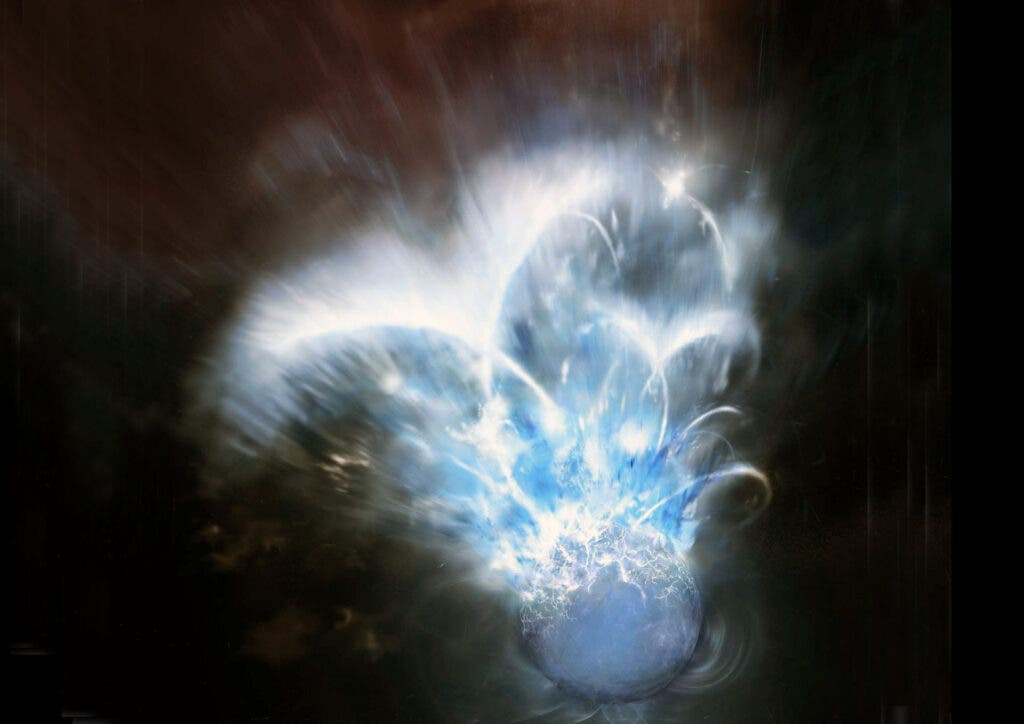
Sure we might have enormous gas giants and menacing asteroids, but compared to other corners of the universe, our solar system is pretty vanilla. There are black holes whose mass exceeds billions of solar masses, generating a gravitational pull so intense that they shape the formation and evolution of entire galaxies. Then there are magnetars, much less famous than black holes but incredibly powerful in their own right. Case in point, astronomers in Spain have witnessed such an object erupt with as much energy as the sun produces in 100,000 years, concentrating it in just 0.1 seconds.
When truly massive stars die, they do so with a bang, triggering a supernova explosion. In the aftermath, some collapse under their own weight, forming into black holes. Those that don’t make the cut, often become neutron stars, second only to black holes in their stupendous density. A teaspoon of neutron star material would weigh around a billion tons, for instance.
There are multiple types of neutron stars, including magnetars. These objects have extremely powerful magnetic fields, a thousand trillion times stronger than the Earth’s, and between 100 and 1,000 times stronger than that of a radio pulsar. They’re essentially the most powerful magnets in the universe.
Magnetars are quite rare, with only a couple dozen such objects having been identified so far. One of them, located in the Sculptor Galaxy about 13 million light-years away, was under observation by astronomers using the Atmosphere-Space Interactions Monitor (ASIM) aboard the International Space Station when a giant flare was detected.
The flare, known as the GRB 2001415 event, released roughly the energy the sun radiates in about 100,000 years in just two short quasi-periodic pulsations that lasted approximately 160 milliseconds.
“Even in an inactive state, magnetars can be one hundred thousand times more luminous than our Sun, but in the case of GRB 2001415, the energy that was released is equivalent to that which our Sun radiates in 100,000 years,” said Dr. Alberto Castro-Tirado, an astrophysicist with the Instituto de Astrofísica de Andalucía del Consejo Superior de Investigaciones Científicas (IAA-CSIC) and the Universidad de Málaga. “It’s a true cosmic monster,” added Professor Víctor Reglero, an astrophysicist at the Universitat de València and co-author of the new study.
The magnetar explosion was detected on April 15, 2020 thanks to an artificial intelligence system integrated with ASIM. If this kind of system wasn’t in place, the astronomers would have been oblivious to the event, whose signal decayed into background noise within a fraction of a second.
No one’s really sure what triggered the eruption, but the researchers believe it could have been due to instabilities in the magnetosphere or ‘earthquakes’ produced in their crust. Further research could help scientists reveal the mechanisms that trigger these frightening but, at the same time, fascinating cosmic burps.
“Although these eruptions had already been detected in two of the thirty known magnetars in our Galaxy and in some other nearby galaxies, GRB 2001415 would be the most distant magnetar eruption captured to date, being in the Sculptor group of galaxies about 11 million light-years,” said Professor Reglero.
“Seen in perspective, it has been as if the magnetar wanted to indicate its existence to us from its cosmic solitude, singing in the kHz with the force of a Pavarotti of a billion suns.”
The findings appeared in the journal Nature.









